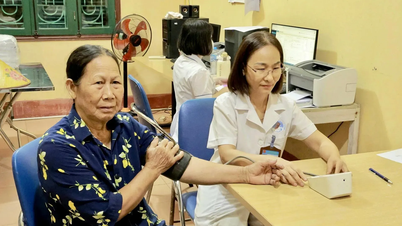Many children hospitalized for influenza A
Currently, the National Hospital for Tropical Diseases is treating nearly 50 patients with influenza A. The number of outpatient examinations and treatments for influenza A has increased rapidly in the past few weeks, most of whom are children.
A 16-month-old patient, TT H ( Hanoi ) was diagnosed with influenza A, with bronchopneumonia and was fortunately discovered and treated promptly. The child was healthy and lived with a family whose older sister had the flu. Three days before being admitted to the hospital, the child had a high fever, runny nose, and a dry cough, followed by wheezing and coughing up thick phlegm. The child was exhausted, had poor cough, and had a lot of phlegm.

Doctors at the Central Hospital for Tropical Diseases examine a child with influenza A. Photo: BVCC
The child came to the National Hospital for Tropical Diseases for examination and the test result for influenza A was positive. The lungs showed signs of secondary infection, the chest X-ray image at admission showed bilateral bronchial lesions. Blood tests reflected a severe infection, increased white blood cells 13.8 G/L, CRP 51 mg/L, more than 10 times higher than normal. If not detected and treated early, the disease can progress rapidly to acute respiratory failure or sepsis. After two days of inpatient treatment, the child responded well, fever reduced, improved breathing, and resumed breastfeeding, but still needed close monitoring.
Another case is a female patient HL (10 years old, Hanoi), admitted to the hospital with a high fever of 39.5°C, severe cough, vomiting more than 10 times/day, sometimes vomiting blood, fatigue, and inability to eat or drink. In addition, the child had symptoms of pain in the bones and joints throughout the body, body aches, and severe headaches - typical symptoms of influenza A infection. The child was diagnosed with influenza A but had no complications. The patient was admitted to the hospital for treatment according to the correct protocol, and was supported with pain relief, anti-emetics, electrolyte replacement, and close monitoring.

Many children with influenza A are treated at the Central Hospital for Tropical Diseases. Photo: BVCC
At Saint Paul General Hospital, out of every 10 children who come to the clinic with a fever, 9 are infected with the flu virus. Dr. Nguyen Thi Hong Nhan - Head of the Department of Pediatric Gastroenterology, Nutrition - Infection, Saint Paul General Hospital said that the number of children with flu and other respiratory viruses is on the rise during the changing seasons. However, most cases are mild and can be treated effectively if detected early. In recent weeks, about 90% of children coming to the clinic have viral diseases, of which 60 - 70% have to be hospitalized for monitoring and treatment, mainly due to high fever, cough, respiratory infections or digestive disorders.
The hospital is currently admitting about 20 children with influenza A, accounting for about 1/3 of the total number of patients being treated at the department. Although the hospitalization rate is quite high, there have been no cases of severe progression requiring ventilator support.
Avoid serious complications
Over the past month, Gia Lam General Hospital has recorded a clear increase in the number of seasonal flu cases, especially in young children, the elderly and pregnant women. On average, the Examination Department of Gia Lam General Hospital receives 30-40 patients with suspected flu symptoms every day.
Dr. Le Quang Minh - Department of Pediatrics, Gia Lam General Hospital said that most of the cases are mild and can be treated as outpatients. However, the hospital has also recorded some cases with complications of pneumonia and otitis media, especially in young children or people with chronic underlying diseases such as cardiovascular disease, diabetes, and bronchial asthma. These cases need to be hospitalized for intensive treatment and close monitoring.

Gia Lam General Hospital doctor examines pediatric patient.
“In fact, many people still confuse seasonal flu with the common cold. This is a very common mistake. The common cold usually has a slow onset, mild symptoms, mainly stuffy nose, runny nose, mild sore throat and rarely high fever. Patients can still go about their normal activities. Meanwhile, seasonal flu is caused by influenza A or B virus, often with a sudden onset with symptoms of high fever above 38-39°C, headache, muscle aches, fatigue, dry cough, sore throat, and even vomiting or diarrhea. Flu can spread quickly and easily cause complications, especially in high-risk groups. Therefore, when experiencing high fever, body aches or difficulty breathing, patients should go to a medical facility early for timely diagnosis and treatment. They should not self-medicate at home,” warned Dr. Le Quang Minh.
Sharing the same opinion, Dr. Nguyen Dinh Dung - Central Hospital for Tropical Diseases said that influenza A is an acute infectious disease transmitted through the respiratory tract, which can occur at any age, but young children, the elderly or people with underlying diseases are at higher risk because their immune systems are weak and susceptible to serious complications. Notably, the early stages of influenza A are often similar to other respiratory viruses, but the disease can progress very quickly, causing serious complications such as pneumonia, respiratory failure or sepsis if not detected and treated promptly.
Most children with influenza A have a high fever, runny nose, and increasing cough, accompanied by fatigue and crying. Older children and adults often have more obvious symptoms of body aches and pains, aching bones and joints. In addition, children may have convulsions due to high fever, vomiting, and diarrhea. If the disease progresses, children may become lethargic, less responsive, refuse to breastfeed, breathe rapidly, or have chest retraction, all of which are warning signs of complications.

Medical experts recommend that parents closely monitor their children's health.
Medical experts recommend that parents should closely monitor their children's health. When children show signs of illness or fever, families should take them to the nearest medical facility for examination, early diagnosis and proper treatment. Families should not arbitrarily use drugs at home, especially antibiotics. Taking children to the doctor in a timely manner will help to treat them properly and limit serious complications.
According to experts, with the increasing number of influenza A cases during the changing seasons, disease prevention, especially by getting the flu vaccine, is extremely important to protect the health of the whole family. People should proactively vaccinate themselves and their children against the flu, especially during the time of increasing epidemics. In addition, each individual needs to maintain personal hygiene, wash hands regularly, wear masks when going to crowded places, and isolate sick people to limit the spread in the family and school.
Source: https://kinhtedothi.vn/gia-tang-ca-cum-a-thoi-diem-giao-mua-nguoi-dan-khong-chu-quan.901623.html




























































































![Dong Nai OCOP transition: [Article 3] Linking tourism with OCOP product consumption](https://vphoto.vietnam.vn/thumb/402x226/vietnam/resource/IMAGE/2025/11/10/1762739199309_1324-2740-7_n-162543_981.jpeg)












Comment (0)